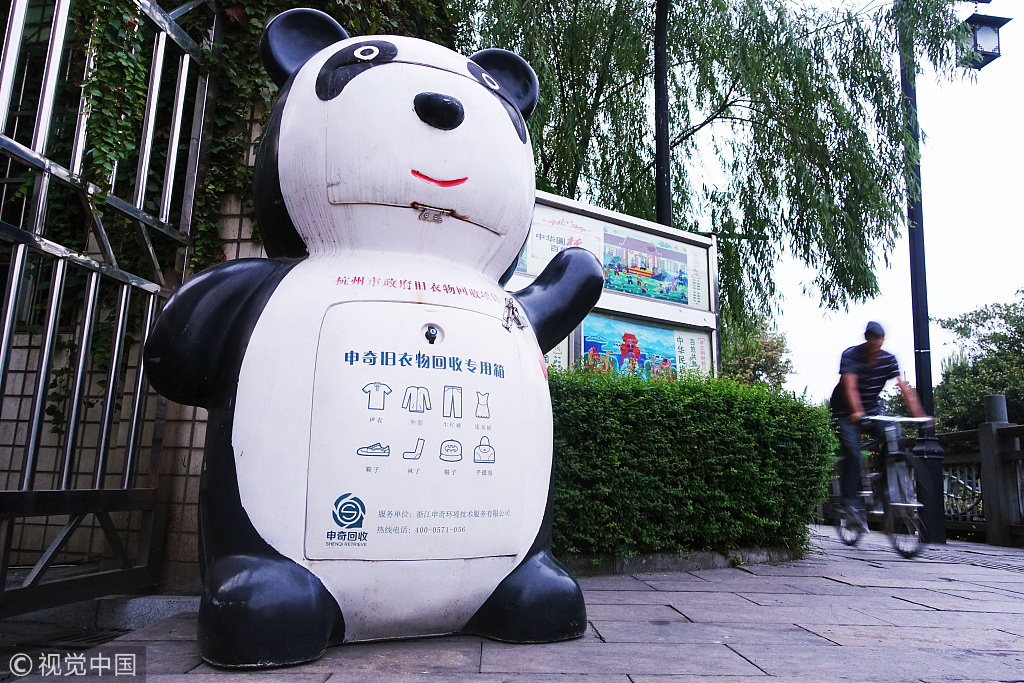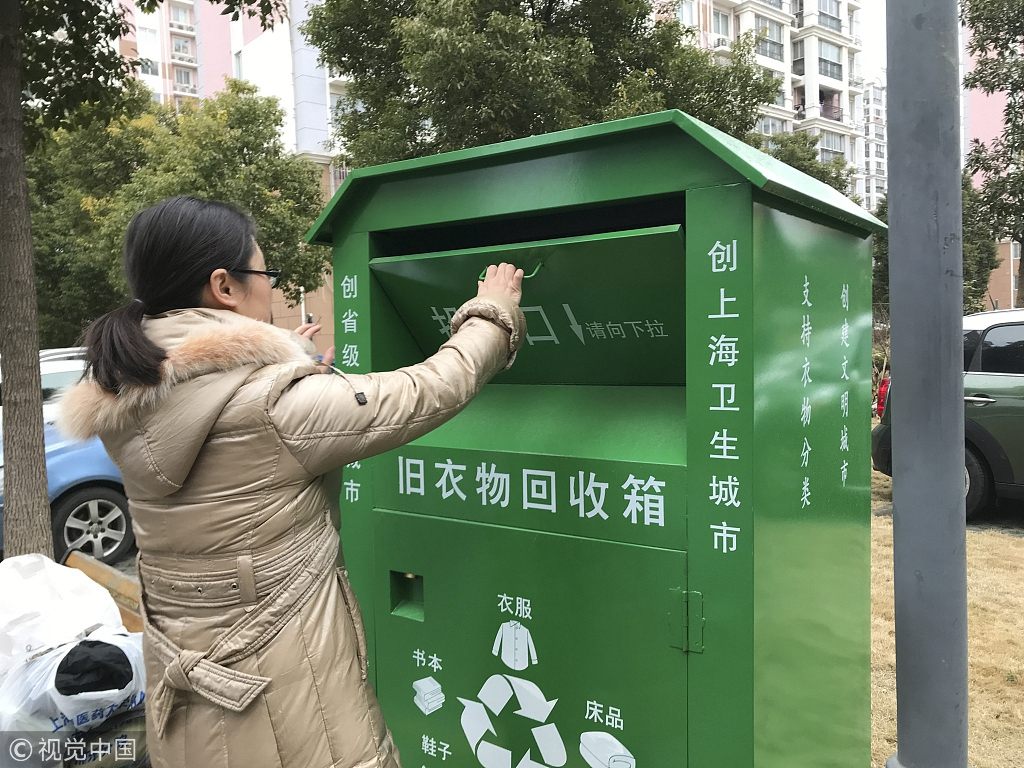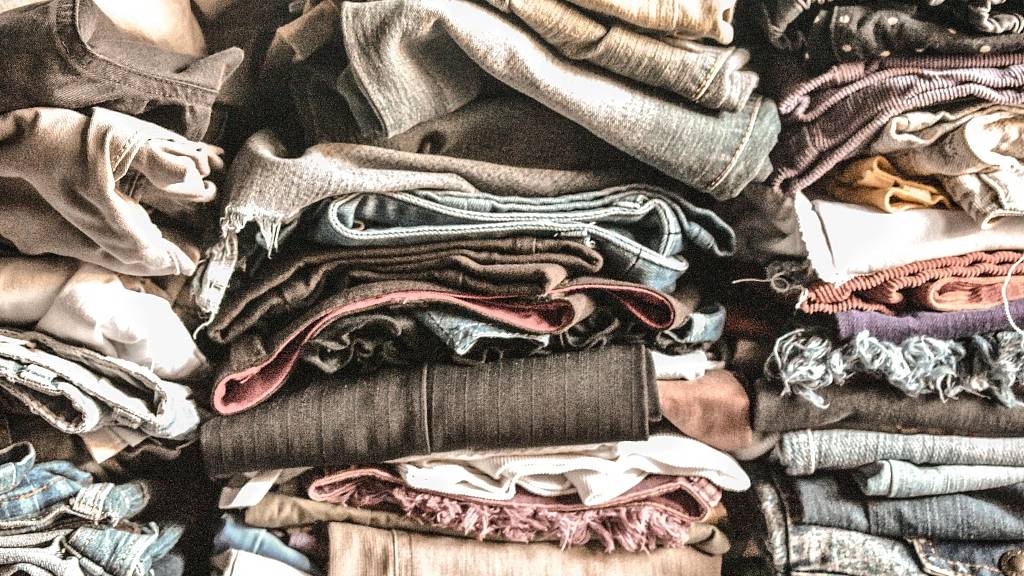City residents in the past few years have been unloading their used and unwanted clothes into donation bins placed in residential communities in China. Some people take the time to pick out unwanted articles in good condition, washing and folding them before making the trip to a drop box nearby. They believe that their donations would help keep a poor family somewhere warm and happy.
That thought alone should put a smile on someone's face, not to mention the relief that their decluttered wardrobe has room for new additions again.
Except that's not what is actually happening.
Last week, several local media reports uncovered in different cities across China that used clothing collected from many of these drop boxes marked for "donation" were not distributed to people in need, but instead resold by textile recycling companies for profit.
The public was disheartened by the news. On Weibo, the question "where did your donated clothes go?" was among the top searches on that day. Many say they felt their kindness was exploited by greedy businesses.
"All the clothes I donated were nice and clean, because I thought they would be worn by poor kids in rural areas. Had I known they were to be sold, I'd have kept them," a netizen posted.
"People will eventually stop giving to charity after too many dishonest things like this," said another.
It is not the first time. In 2017, it was discovered that some recycling factories were pocketing large amounts of money selling zippers they had removed from garments collected from donation bins, while newer clothes were bundled and shipped overseas for resale.
But what about charity?
Unwanted charity
Simply put, people today don't want other people's used clothes. Given a choice, poor people don't want them either.
When clothing donation bins first sprouted across China, the idea was widely welcomed. Queues of people with bags of old clothes near them were a common sight. The boxes, many of which started as part of the local government's charity program, were said to be always full.

A panda-shaped clothing recycling bin is seen in a residential community in Hangzhou, east China's Zhejiang Province, September 17, 2015. /VCG Photo
A panda-shaped clothing recycling bin is seen in a residential community in Hangzhou, east China's Zhejiang Province, September 17, 2015. /VCG Photo
This was until other kinds of bins appeared – those set up by for-profit recyclers posing as charitable organizations.
China's Charity Law requires all charitable organizations to obtain public fundraising qualifications, with a registration number issued by the Ministry of Civil Affairs. The law states that conducting public fundraising without qualifications or using false information to trick or coax others into making donations would carry a fine of up to 200,000 yuan (29,760 U.S. dollars).
These unregistered "donation" bins have misled many people into believing their donated clothes are going to be worn by others, when in fact they are merely recycling them like other garbage.
If it is illegal, then why does it keep happening?
For Chinese who have experienced periods of scarcity in their lives, the only guilt-free way for them to part with old clothes is giving them to a charitable cause. To think anyone would profit from their goodness is entirely unacceptable.
But the reality is that even legitimate clothing donations mostly end up in landfills. But textile recycling, on the other hand, is increasingly encouraged.
The global fast fashion boom in recent decades has resulted in people throwing away more clothes after wearing them fewer times, the Ellen MacArthur Foundation found. It has also made new clothes a lot more affordable than before, meaning less demand for used ones.
While the supply far exceeds the demand, the costs for getting these second-hand donations to their intended recipients are high when accounting for the transportation and manpower needed for sorting and processing the volumes. And, it's found that only less than 20 percent of used clothes are considered good enough to be donated.
"Particularly due to the advent of cheap, disposable clothing, charities have seen themselves transformed into dumps that accept clothes of varying conditions in ever-increasing volumes," said Elizabeth Cline, author of "Overdressed: The Shockingly High Price of Cheap Fashion."

Workers sort large piles of donated clothing collected from recycling boxes in a sorting factory in Xiangyang, central China's Hubei Province, October 13, 2016. /VCG Photo
Workers sort large piles of donated clothing collected from recycling boxes in a sorting factory in Xiangyang, central China's Hubei Province, October 13, 2016. /VCG Photo
Disposable fashion is a big polluter
The apparel industry is one of the most energy intensive and polluting industries in the world. A garment affects the environment throughout its life cycle starting from cotton farming, manufacturing, retailing to disposal.
Textile production emits more greenhouse gases than all international flights and maritime shipping combined, while releasing plastic microfibers equivalent to more than 50 billion plastic bottles into the ocean every year, according to the Ellen MacArthur Foundation.
Textile dyeing and finishing contribute to 17-20 percent of all industrial water pollution, said the World Health Organization. And official data from the Ministry of Environmental Protection show that the fashion industry is the third largest discharger of wastewater in China.
As a global manufacturing center, China has already borne the brunt of environmental hazards caused by fast fashion. Now a rapidly growing consumer market, the country is suffering from further pollution from textile waste that sit in landfills.
According to the China Association of Circular Economy (CACE), the country throws away around 26 million tons of clothes each year, with less than one percent recycled.
Currently, the vast majority of discarded clothing is buried or burned, because the synthetic materials used to make them are hard to break down, said Professor Wang Huaping from Donghua University. However, landfilling takes up too much land and burning pollutes the air, making these methods unsustainable, he said.
The most commonly used fiber in clothing, polyester, takes more than 200 years to decompose, which will then release greenhouse gases like carbon dioxide and methane into the atmosphere.

Activists place a mannequin near a sewage treatment plant in Xiaoshan, east China's Zhejiang Province, to protest water pollution caused by clothing factories discharging toxic wastewater into the Qiantang River, December 4, 2012. /VCG Photo
Activists place a mannequin near a sewage treatment plant in Xiaoshan, east China's Zhejiang Province, to protest water pollution caused by clothing factories discharging toxic wastewater into the Qiantang River, December 4, 2012. /VCG Photo
What to do with unwanted clothes is not only a headache for the consumer, however. Retailers worldwide are also looking for ways to address the issue – and make consumers feel better about their purchases. Some big fashion chains have launched in-store recycling programs allowing customers to bring in worn clothes, sometimes in exchange for discount vouchers.
It is essentially the same thing that recycling companies in China are doing – sorting, disassembling and sterilizing the textiles for reuse. The understanding is that recycling clothes for any purpose, such as turning them into cleaning mops and insulation materials, prolongs the fabric's lifespan and helps the environment.
Hundred-billion business
Experts believe that a regulated recycling industry that creates jobs and profits is the most practical way to alleviate some of the negative impacts from the apparel industry.
"Recycling and reusing discarded textiles is not only environmental protection work, it is also a new market which will generate an industry worth hundreds of billions of yuan," said Jiang Shicheng, a fellow at the Chinese Academy of Engineering (CAE).
Jiang said researchers at CAE are focusing on improving the recycling system for synthetic fiber, which is responsible for the majority of discarded clothes gone to waste.
Besides technological upgrades, setting national standards for textile recycling is necessary for ensuing proper sanitation and quality of the output, suggested the Alliance for Waste Textiles Comprehensive Utilization Industry for CACE.
All of that, of course, is not going to happen overnight. But an incentive-based model is already producing results.

A resident drops unwanted clothes into a clothing recycling box in Shanghai, February 15, 2018. /VCG Photo
A resident drops unwanted clothes into a clothing recycling box in Shanghai, February 15, 2018. /VCG Photo
In 2018, Alibaba's second-hand trading platform Xianyu, which offers users a clothing recycling service, recycled 8,438 tons of used clothes, reducing 30,000 tons of carbon emission or the equivalent of removing 10,000 cars off China's roads for a year. The recycling program also allows users to participate in an online green scheme to save energy and plant real trees.
When effectively done, clothing recycling can be an ethical way to get more out of our old clothes and regretted purchases. Instead of falsely advertising themselves as charities, businesses have the chance to do real public good, and that includes charity.
As for protecting the environment, neither recycling nor giving to charity could justify the current rate of clothing consumption.
A better solution? Buy less.






